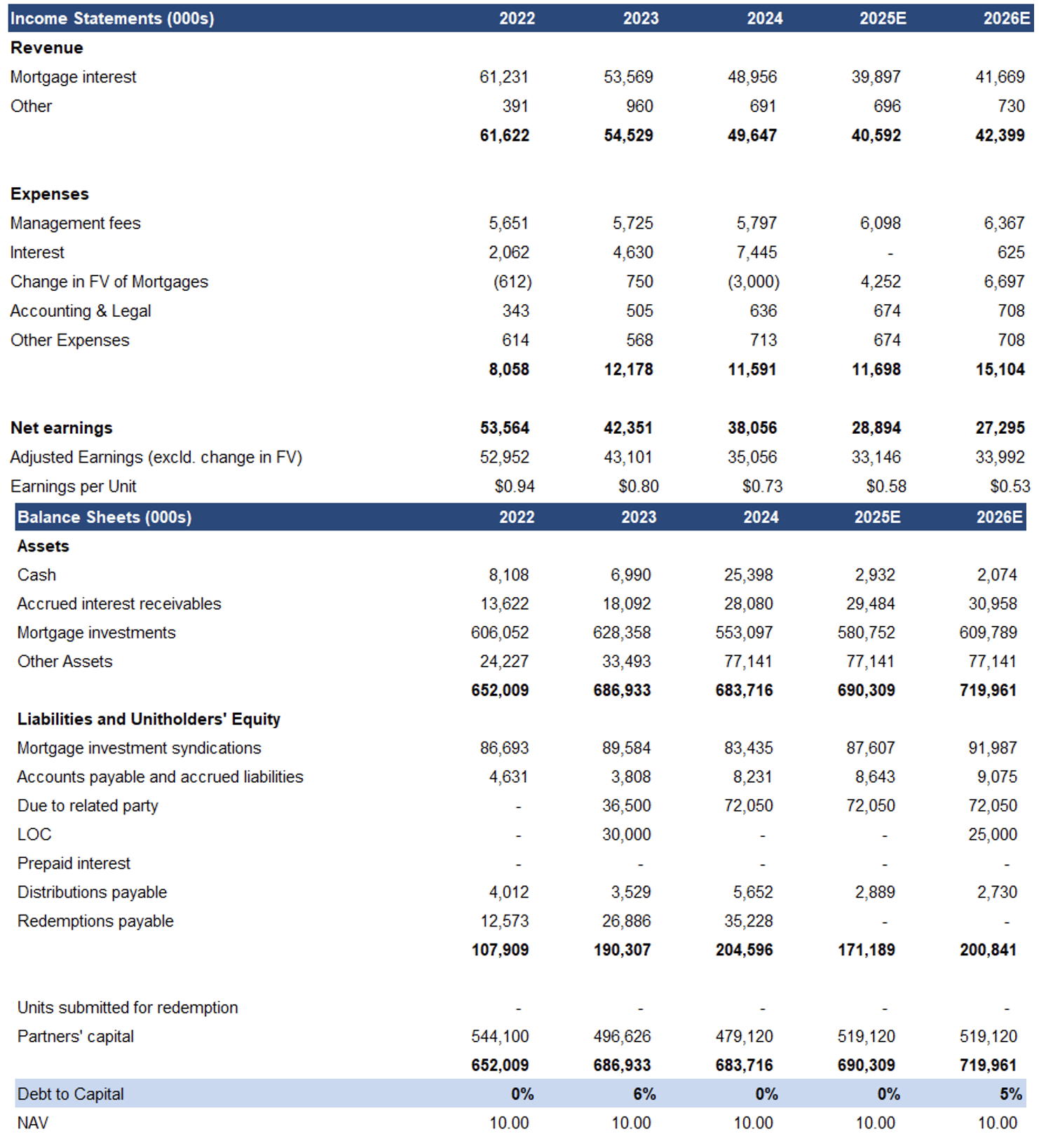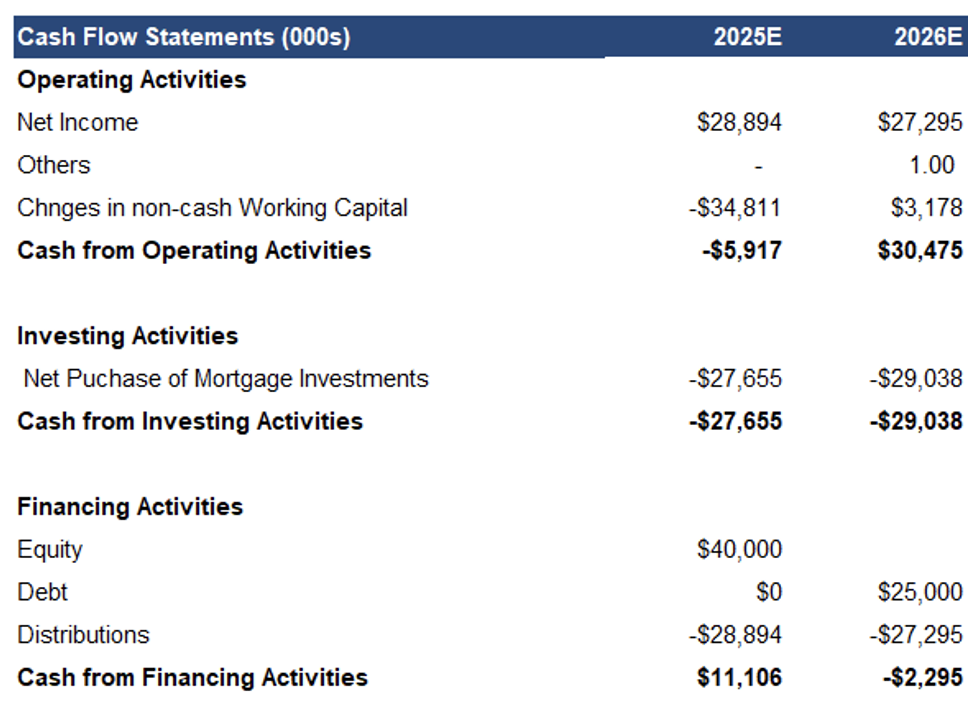- At the end of 2024, the fund managed $553M in mortgages, with 38% concentrated in Florida, 11% in Texas, and the remainder distributed across various other states.
- At the end of 2024, the fund had $211M (39% of the portfolio) in impaired mortgages and foreclosed assets, significantly above the sector average of 6%, indicating elevated risk. However, management has allocated just $6M (1% of mortgages and foreclosed assets) for loan loss allowances, suggesting they anticipate limited losses. We remain cautious and will closely monitor how management works to resolve and recover impaired mortgages in the coming quarters.
- While Trump’s tariff threats have heightened uncertainty amid trade tensions and geopolitical risks, recent deals with the U.K. and China have partially restored investor confidence. We expect Trump to reverse or soften most new measures due to their potential negative impact on U.S. consumers and businesses. We maintain a stable outlook on U.S. real estate, supported by healthy economic metrics.
- We find high-yielding funds, like Romspen, increasingly attractive in the current declining rate environment. This is because MIE lending rates are less elastic, meaning their yields tend to decline less in a falling rate environment, and rise more slowly in a rising rate environment.
- We are projecting a yield of 5.8% in 2025 vs 7.6% in 2024. In comparison, publicly traded U.S. REITs currently offer a dividend yield of 3% - 4%.
Risks
- Highly competitive sector
- A downturn in the real estate sector may impact the company’s deal flow
- Principal is not guaranteed; no guaranteed distributions
- Default rates can rise during recession
- Construction/development properties tend to carry higher risks than already-built operating properties

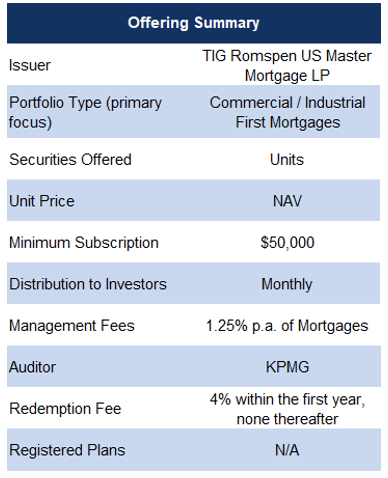
Business Overview
Romspen US Mortgage Investment Fund channels investor capital into TIG Romspen US Master Mortgage LP (“TIG”), the entity holding mortgages, and related investments. The fund is managed by Romspen Investment Corporation, which also oversees the Romspen Mortgage Investment Fund (“RMIF”), one of Canada’s largest non-bank commercial and industrial lenders. At the end of 2024, TIG reported $0.7B in assets under management, while RMIF managed $2.5B.
The fund is a Mortgage Investment Entity (MIE) primarily focused on short-term commercial and industrial first mortgages across the U.S. Its target properties include multi-purpose, industrial, retail, and multi-family residential properties such as condominiums and apartment buildings. The fund provides construction loans, pre-development financing, and mortgages on revenue-generating properties.
Alternative lenders are typically externally managed by the founders through a separate management company, which originates and manages mortgages for the lender. In return, the management company earns asset management fees and/or performance fees from the lender, and usually receives 100%, or a portion of the origination fees received from the borrower.
- A lender’s revenue primarily comes in the form of interest earned from borrowers.
- Lenders finance their mortgage portfolio through debt (banks), and equity (investors).
- After deducting management / origination fees, loan interest and other operational expenses, lenders pay out net income as dividends to investors.
The following table shows how Romspen’s portfolio compares to that of other similar entities.
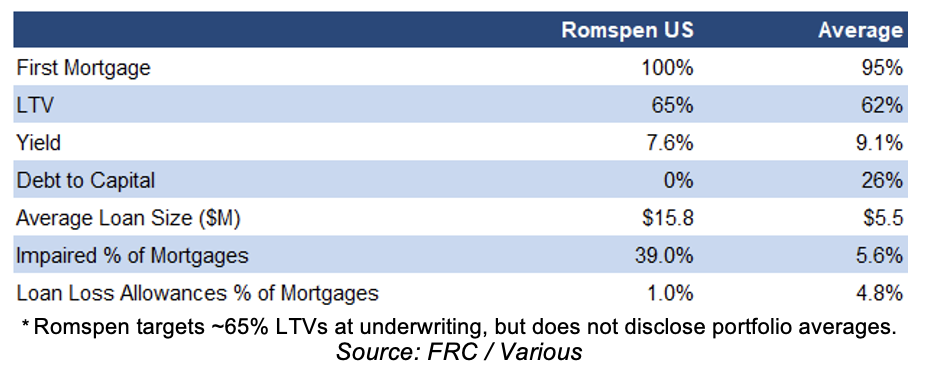
60+ years in business; 80+ employees. TIG was formed in 2018
RMIF was formed in 2005. Short-term loans secured by real estate
Portfolio Overview
Mortgage receivables increased from $438M at the end of 2019, to $553M by 2024. In 2024, receivables were down 12% YoY amid softer lending activity
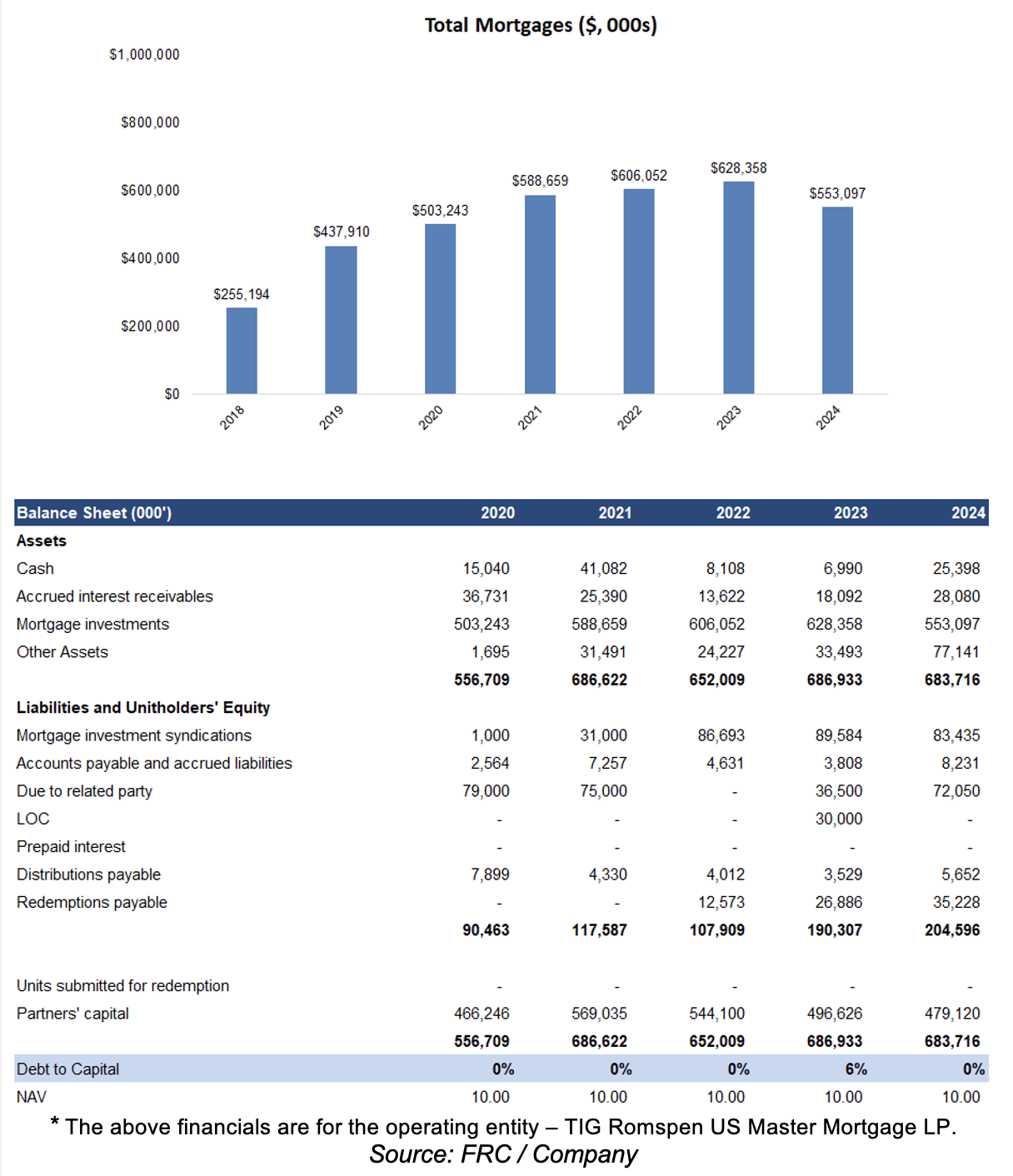
Unlike most lenders, the fund does not use leverage to enhance yields
In 2024, originations were down 39% YoY, while repayments were up 35% YoY
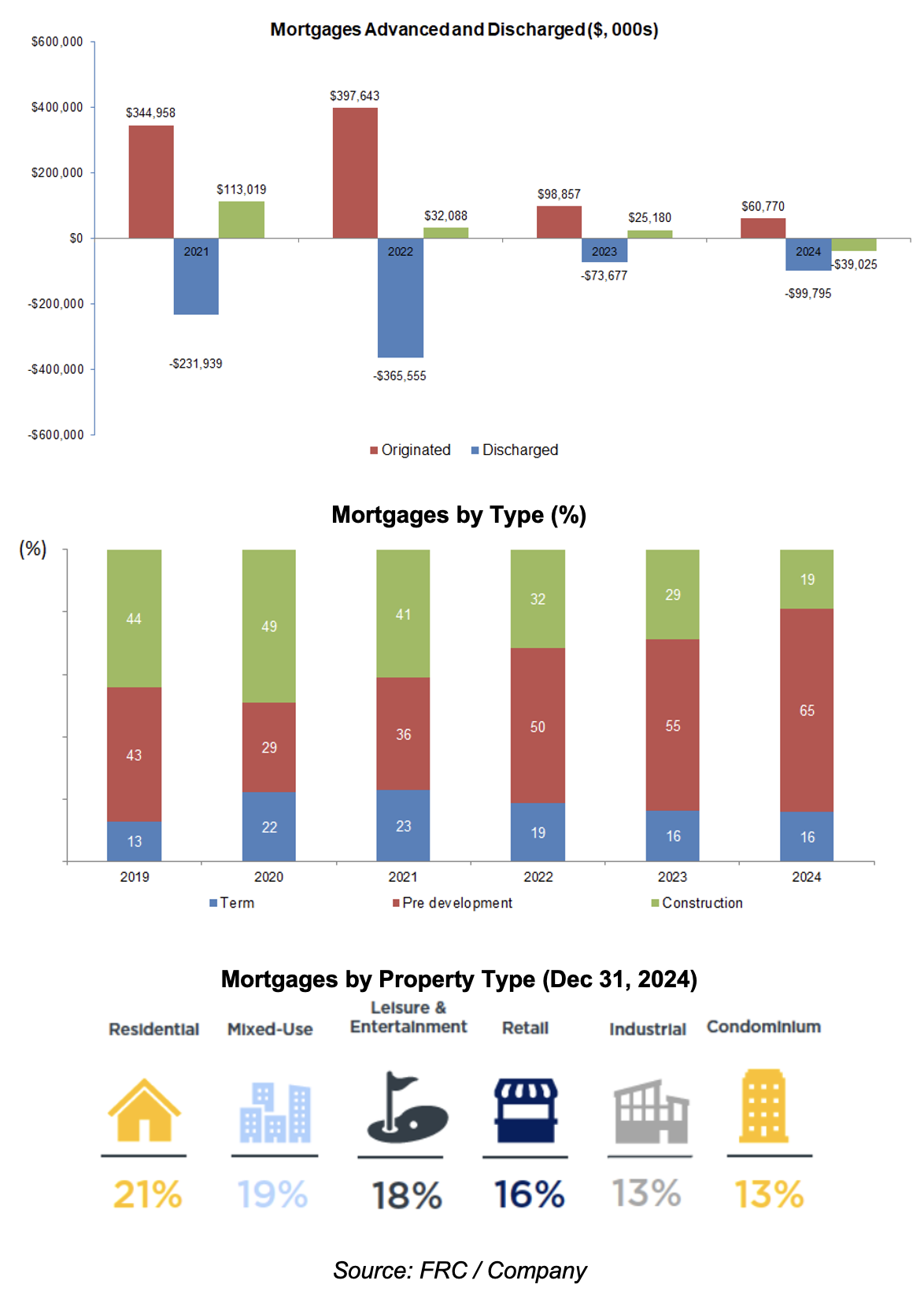
At the end of 2024, term mortgages (income producing properties/lower-risk category) accounted for 16%, while pre-development, and construction mortgages accounted for the remaining 84% of the portfolio
Residential/mixed-use made up 53% of the portfolio, with commercial mortgages accounting for the remaining 47%
At the end of 2024, the average mortgage size was $16M, up 16% YoY
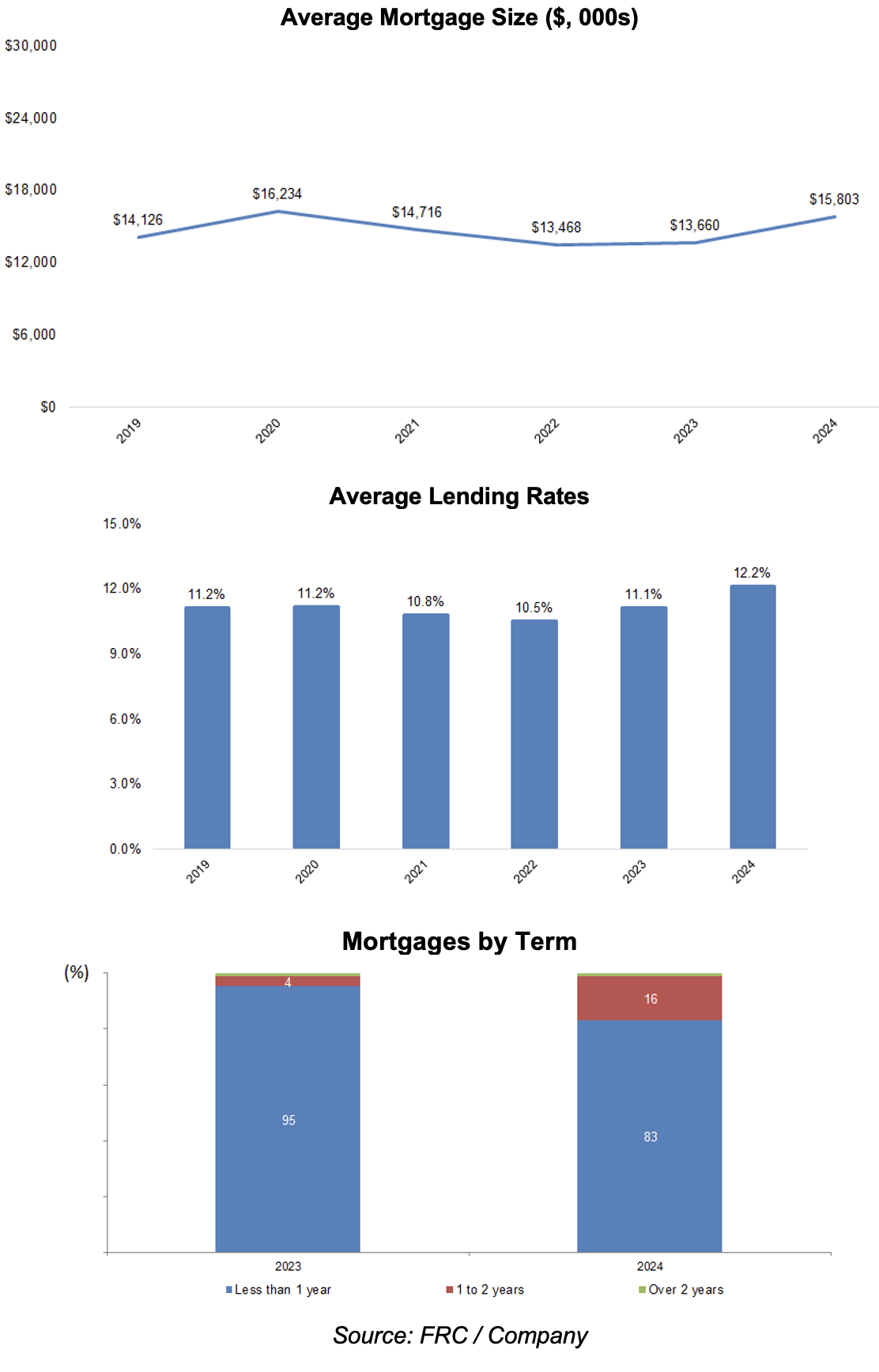
Despite market rates falling in H2-2024, the fund's largely fixed-rate portfolio led to an increase in average lending rates, as most mortgages were originated at higher rates in H1-2024. As mortgages mature, we expect them to be reinvested at lower rates
83% of mortgages are due in less than a year; low-duration allows the fund to adjust their lending rates quickly

At the end of 2024, the fund had $211M (39% of the portfolio) in impaired mortgages and foreclosed assets, up from 16% at the end of 2023, primarily driven by a single large impaired loan
The sector average impairment rate is 6% of mortgages
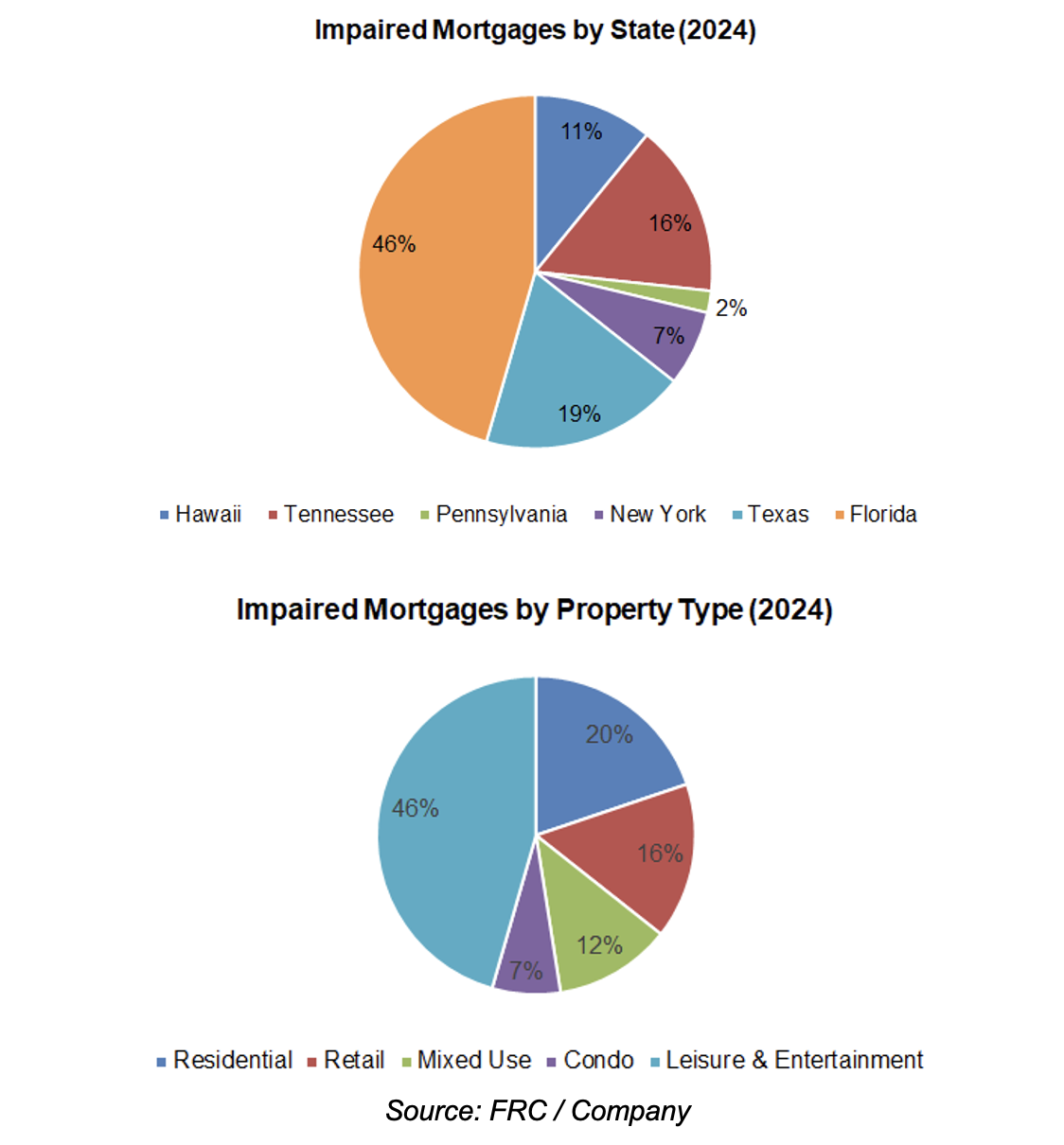
46% of impaired mortgages were in Florida. Leisure and entertainment mortgages also account for 46% of the portfolio
With $211M in mortgages impaired or in foreclosure, representing 39% of the total of net mortgage receivables and foreclosed assets, we believe the fund faces significant risk. However, management has allocated just $6M (1% of mortgage and foreclosed assets) for loan loss allowances, indicating they do not anticipate major losses. We will monitor the fund closely over the coming quarters to see how management addresses these troubled mortgages and aims to restore them to good standing.
Financials
In 2024, revenue was down 12% YoY, and profit was down 21% YoY, primarily due to lost interest revenue from impaired mortgages
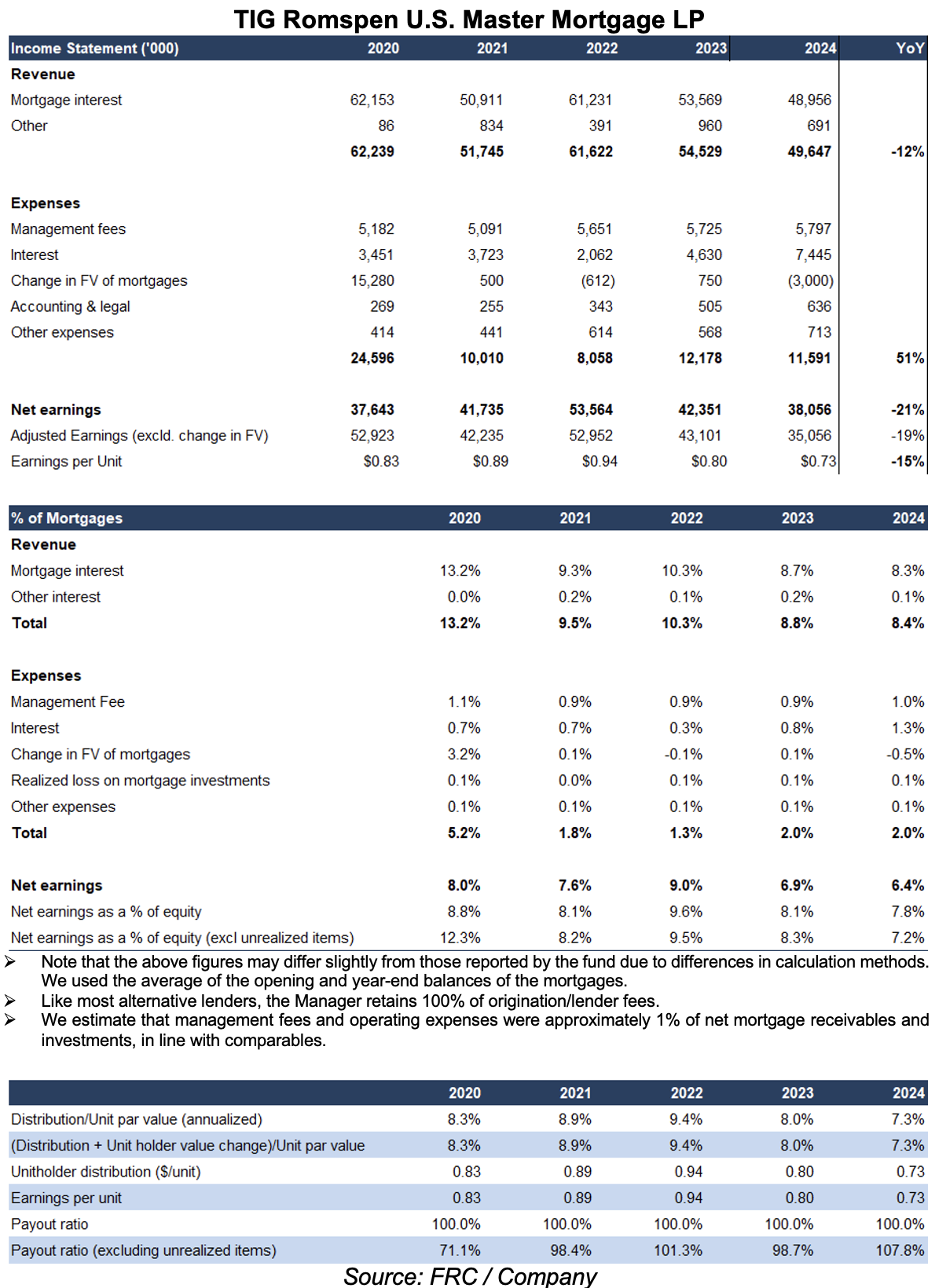
Net earnings as a percentage of mortgages trended lower as well. 2024 distributions were down 9% YoY to $0.73/unit, or 7.3% of NAV

U.S. Real Estate Outlook
While Trump’s tariff threats have increased uncertainty amid escalating trade tensions, geopolitical risks, and the potential for a global GDP slowdown, the recent trade deal with the U.K., and temporary agreement with China have partially restored investor confidence. We believe Trump is likely to reverse or soften most of his administration’s new measures, given their potential negative impact on U.S. consumers and businesses. We maintain a stable outlook on the U.S. real estate sector, driven by a relatively healthy outlook for key economic metrics. The International Monetary Fund projects U.S. GDP growth of 1.8% in 2025 vs 2.8% in 2024.
Although unemployment has risen YoY, it remains close to historical lows

Cooling inflation suggests the potential for additional rate cuts later this year
Consumer spending remains robust, up 3% in 2024, with consensus estimates projecting 1.7% growth in 2025
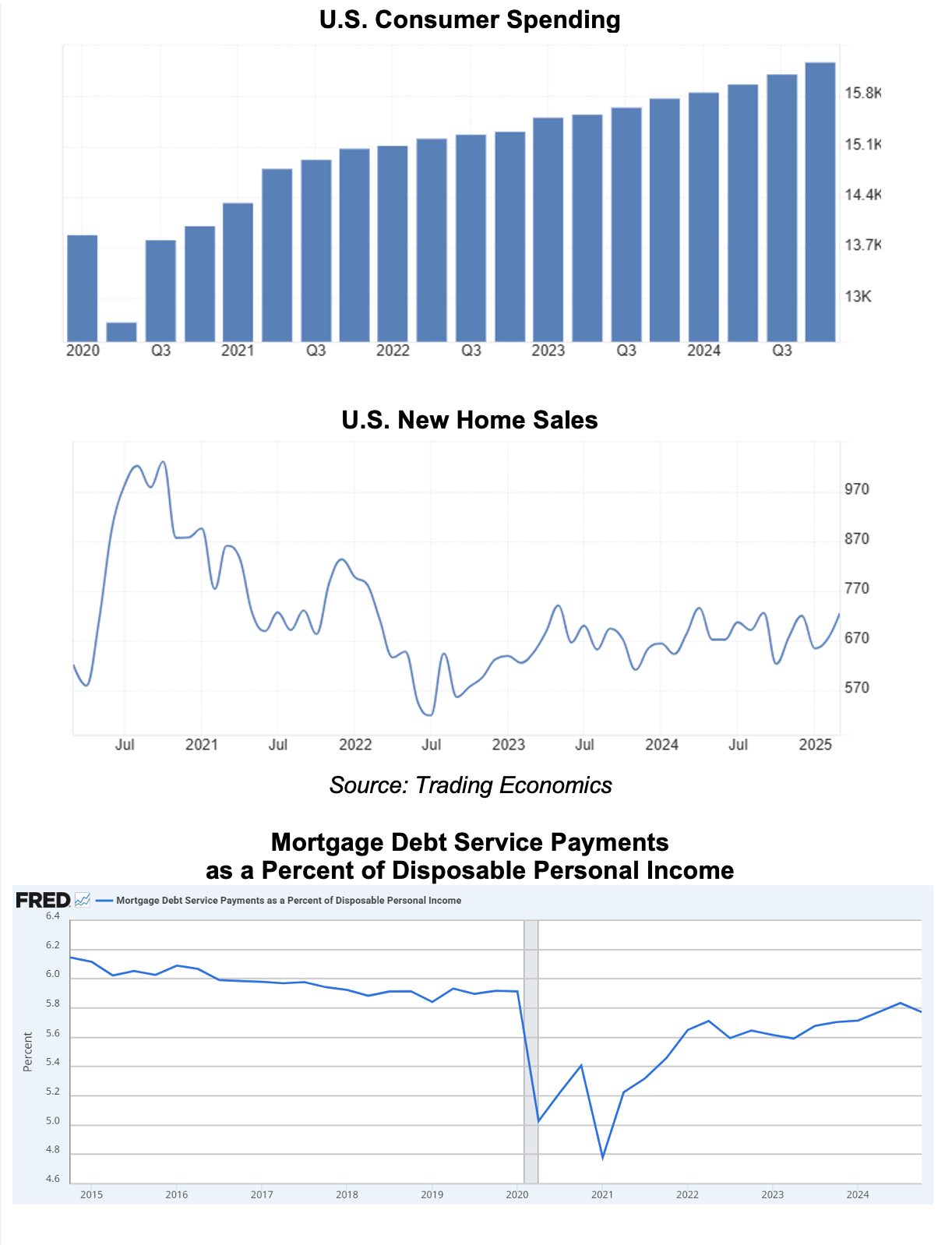
New home sales are on the rise, fueled by lower mortgage rates
Sector delinquencies, which have historically tracked interest rates, have risen over the past two years due to Fed hikes but remain below historical averages
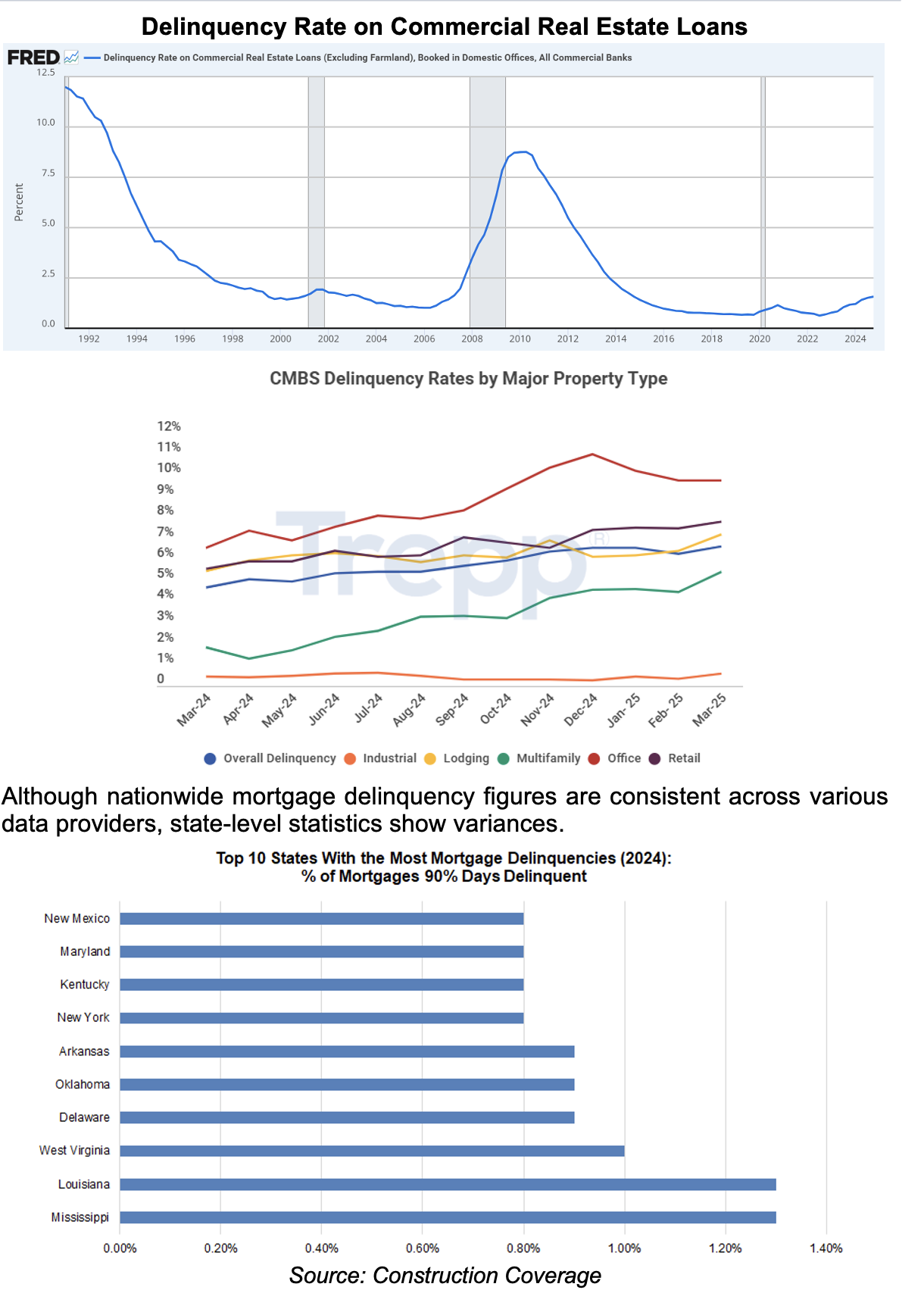
Romspen’s primary targets — residential and industrial (accounting for 60-70% of its portfolio) — have relatively low delinquency rates
According to one source, Florida and Texas - Romspen's primary targets - are not among the top 10 states with the highest mortgage delinquencies
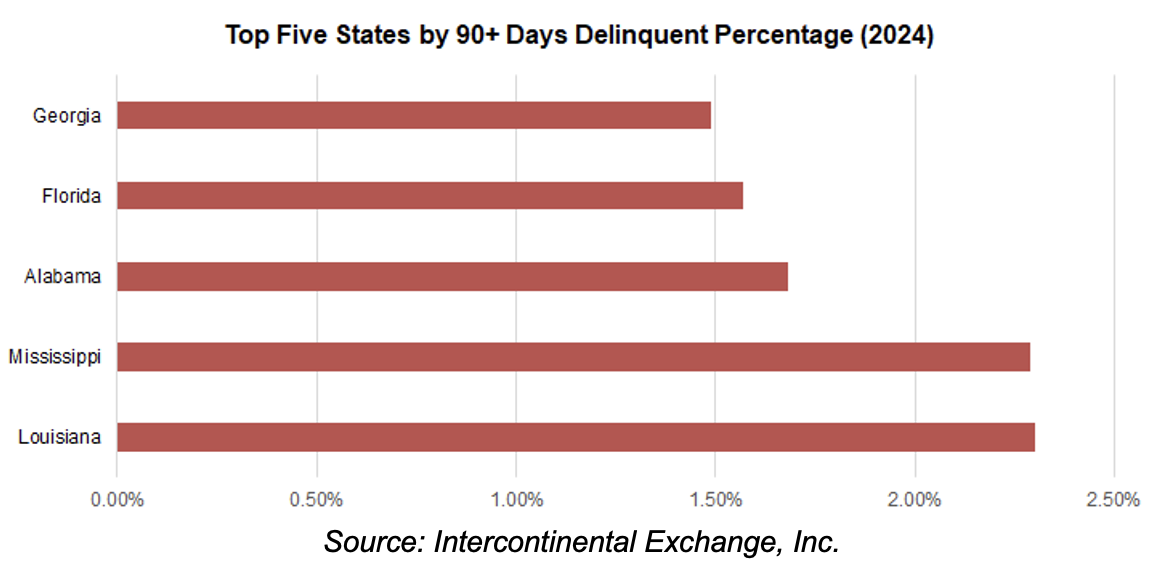
However, another source indicates that Florida had the fourth-highest delinquency rate in 2024
We note that Florida and Texas have seen some of the highest migration-driven population gains in recent years, fueled by low taxes, affordable housing, warm weather, and relatively robust job markets. We note that Florida’s positive outlook is partially tempered by the high frequency and intensity of hurricanes and flooding, as well as the relatively high property insurance premiums.
Although mortgage delinquencies, especially in Florida, remain a concern for lenders like Romspen, we believe the risk is easing amid falling mortgage rates, and stable economic indicators, such as low unemployment, robust consumer spending, and manageable debt service ratios. Given this backdrop, we anticipate a rebound in pre-sales, and reduced financing costs for developers, and increased transaction volumes for real estate lenders this year.
FRC Projections and Rating

With rates trending downward, we foresee yields declining in 2025 and 2026. We are projecting a yield of 5.8% in 2025

Our estimate for the 2025 yield varies between 5.2% and 6.4%, as loan loss provisions and lending rates vary
We are concerned about the high percentage of impaired or foreclosed mortgages, even though management does not anticipate material losses. Close monitoring is needed to assess whether management can successfully resolve these assets.
Risks
We believe the fund is exposed to the following key risks:
- Operates in a highly competitive sector
- Significant asset stress; close monitoring needed to assess management’s recovery plan
- Investments in mortgages are typically affected by macroeconomic conditions, and local real estate markets
- A downturn in the real estate sector may impact the company’s deal flow
- Principal is not guaranteed; no guaranteed distributions
- Construction/development properties tend to carry higher risks than already-built properties
- Timely deployment of capital is critical
- Default rates can rise during recession
APPENDIX
These financials are for the operating entity – TIG Romspen US Master Mortgage LP.
